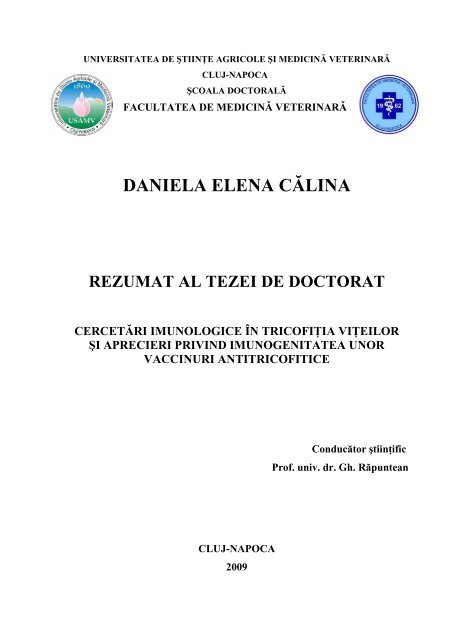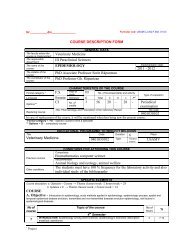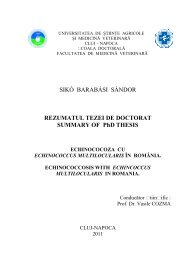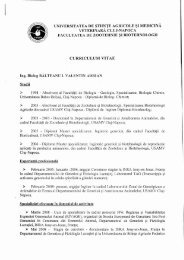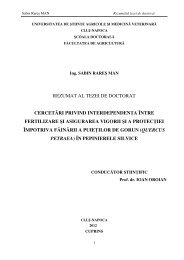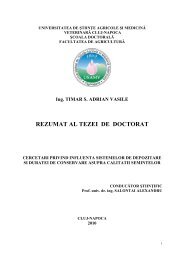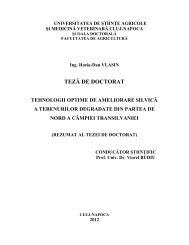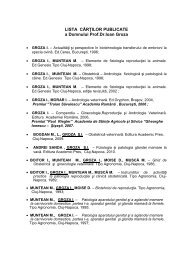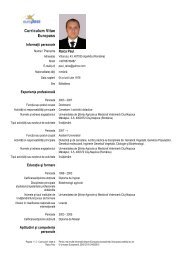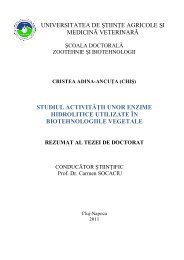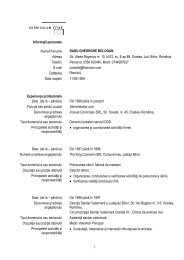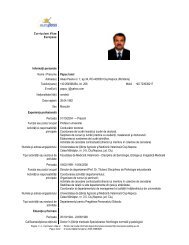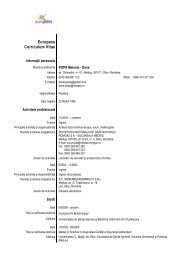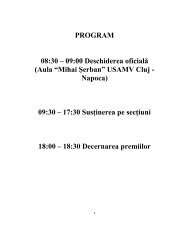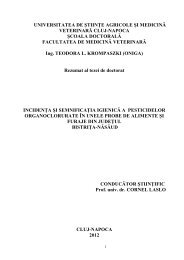rezumat Calina Daniela - USAMV Cluj-Napoca
rezumat Calina Daniela - USAMV Cluj-Napoca
rezumat Calina Daniela - USAMV Cluj-Napoca
Create successful ePaper yourself
Turn your PDF publications into a flip-book with our unique Google optimized e-Paper software.
Fig. 6, TricofiŃie la omLeziune tipicăFig. 7, Colonii de T. verrucosum, tulpină izolatăde la om-mediul gelozat cu cloramfenicolTrebuie menŃionat faptul că există o strânsă corelaŃie între rezultatele examenului microscopic şi a celuicultural, existând totuşi situaŃii în care izolarea miceŃilor pe mediile de cultură nu a fost însoŃită şi de evidenŃierealor microscopică sau invers. Utilizând testul „t” pentru a compara rezultatele examenului microscopic şi a celuicultural, după cum reiese din figura 8, valoarea t>0,05. În consecinŃă corelaŃia dintre cele două variante, nu poatefi considerată semnificativă din punct de vedere statistic.Probe pozitive microscopicProbe pozitive culturalProcentul de probe pozitive140120100806040201121215142342920 180Ferma 1 Ferma 2 Ferma 3 Ferma 4Fig. 8, SituaŃia comparativă dintre probele pozitive microscopic şi cultural pentru cele patru fermeÎn capitolul 8, intitulat „Stabilirea capacităŃii imunizante a vaccinurilor antitricofitice prinadministrare la tineret bovin şi bovine adulte, în condiŃii de fermă” s-a urmărit verificarea toleranŃei locale şigenerale; evoluŃia leziunilor clinice după administrarea vaccinului Trichoben MenŃionăm că în cercetările delaborator (examen bacterioscopic şi bacteriologic) am luat în studiu şi un vaccin de producŃie românească numitTricovac, produs de Institutul Pasteur.Vaccinul pentru testare este preparat dintr-o tulpină de Trichophytonverrucosum, conŃinând minimum 2,5 x 10 6 elemente structurale, dispersate într-un mediu liofilizat. Cercetărilerealizate cu privire la testarea clinică a vaccinului Trichoben prin administrarea în condiŃii de fermă au relevaturmătoarele aspecte:viŃeii vaccinaŃi în scop terapeutic cu doza de 5 ml (corespunzătoare vârstei de 3 săptămâni-3 luni) auprezentat o tendinŃă de vindecare a leziunilor încă după prima administrare a vaccinului. La animalelecare nu au manifestat clinic tricofiŃie, după aproximativ 10 zile de la vaccinare, au apărut la locul deinoculare o placardă tricofitică cu diametru de 3-4 cm, care în termen de 5-6 zile a început să regreseze.La 28 de zile de la administrarea vaccinului s-a observat regresia leziunilor de hipercheratoză cusubŃierea crustelor şi regenerarea firelor de păr. Vindecarea leziunilor începe de la trenul posterior, celmai greu se vindecă leziunile cu localizare perioculară (Fig. 9, 10, 11, 12).viŃeii vaccinaŃi în scop preventiv cu doza de 5 ml (corespunzătoare vârstei de 3 -6 luni) nu au prezentatreacŃii post vaccinale la locul de inoculare al vaccinului.vindecarea leziunilor a depins foarte mult de o serie de factorii: îmbunătăŃirea condiŃiilor de întreŃinereşi alimentaŃie, izolarea animalelor afectate, respectarea protocolului şi a dozelor de vaccinarecorespunzătoare vârstei dar şi a stadiului boli.
probe pozitive probe negative total probeDenumire fermaSDE CojocnaCarmolimpCojocnaBerindJucuGadalin200575151552525045595772671351280 20 40 60 80 100 120 140 160numar probe examinate serologicFig. 17, Raportul dintre probele pozitive şi cele negative la controlulefectuat înainte de vaccinare în cele 6 fermeprobe pozitive probe negative total probeDenumire fermaSDE CojocnaCarmolimpCojocnaBerindJucuGadalin2326155103418231931595249425072931350 20 40 60 80 100 120 140 160numar probe examinate serologicFig. 18, Raportul dintre probele pozitive şi cele negative la controlul efectuatdupă vaccinare în cele 6 fermeDin analiza datelor obŃinute rezultă că în urma vaccinării viŃeilor cu Trichoben, se iniŃiază un răspunsimun prin producerea de anticorpi specifici, care se pot evidenŃia prin reacŃia de imunodifuziune în gel de agar.Trebuie subliniat faptul că răspunsul imun al viŃeilor diferă ca intensitate de la o fermă la alta. Spreexemplu a dat rezultate foarte bune în ferma din Cojocna şi Gădălin, unde viŃeii aveau o stare de întreŃinere bunăşi a dar rezultate mai slabe în ferma Jucu, unde starea de întreŃinere a viŃeilor a fost necorespunzătoare. Chiardacă nu toŃi viŃeii vaccinaŃi au răspuns printr-o reacŃie pozitivă, vaccinarea merită a fi luată în considerare ca ometodă de urmat, mai ales în fermele în care tratamentele clasice nu dau rezultate. Mai mult dacă vaccinările sepractică preventiv, numărul indivizilor care fac boala este foarte scăzut, iar leziunile sunt slab exprimate şi autendinŃa de vindecare.Indiscutabil mecanismul răspunsului imun în tricofiŃia la bovine, mai prezintă încă necunoscute, iarstructura antigenică a tulpinilor de Trichophyton trebuie descifrată, pentru a cunoaşte care dintre substanŃelecomponente are ce mai bună imunogenitate.Anticorpii sunt proteine serice şi anume gamaglobuline. Grupul globulinelor de care aparŃin anticorpii afost numit imunoglobuline. Prin cercetări fizico-chimice s-a ajuns la concluzia că anticorpii sunt tipuri de
globuline modificate în cursul răspunsului imun. În urma determinărilor efectuate au rezultat următoarele valorimedii (raportat la proteina totală) la loturile de viŃeii bolnavi, comparativ cu cei sănătoşi (Tabel nr.2):ParametricalculatiValorile medii ale proteinelor totale la loturile de bovine cu tricofiŃie(parametrii statistici; 10 3 /mm 3 )Proteineg/dlLot experimentalAlbumineg/dlγ Globulineg/dlProteineg/dlLot martorAlbumineg/dlTabel nr.2γ Globulineg/dlMinim 4,38 1,88 0,8 4,64 2,23 0,75Maxim 6,88 2,96 1,93 6,09 2,73 1,21Media 5,92 2,48 1,22 5,56 2,52 1,01Dev. St 0,72 0,37 0,33 0,58 0,2 0,16Lizozimul conŃinut în probele biologice (ser sanguin) determină, în contact cu tulpina bacterianăMicrococcus luteus, liza celulară cu clarificarea mediului de reacŃie. În urma măsurătorilor realizate şi a corelăriivalorilor cu concentraŃia lizozimului s-a observat că valorile medii ale acestui efector umoral sunt mai mici lalotul martor, comparativ cu lotul experimental la care s-a administrat vaccinul, la toate recoltările, cu micidiferenŃe dar care nu sunt semnificative statistic.În capitolul 11, intitulat „Evaluarea statusului imun celular la viŃeii cu tricofiŃie” pentru a seevidenŃia modalităŃile de reacŃie a organismului în urma vaccinări antitricofitice şi a se face o corelaŃie întreaspectele clinice şi activitatea organelor hematopoetice, s-au prelevat probe de sânge fără anticoagulant în ziua 0,14 şi 28 după vaccinare, efectuăndu-se următoarele determinări:numărarea leucocitelor totale prin metoda cu lichide de diluŃie Tőrk utilizănd camera de număratBőrker- Tőrk dar s-a utilizat şi aparatul Abacus Junior Vet iar valorile au fost exprimate în 10 3 /mm 3 ;numărarea eozinofilelor s-a făcut ca şi in cazul leucocitelor totale, utilizându-se aparatul Abacus JuniorVet, iar exprimarea s-a făcut în 10 3 /mm 3 ;formula leucocitară ( exprimare procentuală), preparate colorate Panoptic şi May-Grünwald-Giemsa.Rezultatele obŃinute au fost prelucrate statistic în sistemul de operare Windows XP cu care s-aucalculat:media aritmetică şi deviaŃia standard;semnificaŃia statistică a diferenŃelor (testul „t”) dintre variante respectiv loturi.Pe baza rezultatelor obŃinute la numărarea polimorfonuclearelor şi a limfocitelor respectiv monocitelors-a întocmit tabelul nr. 3 ce conŃine media aritmetică a valorilor pe fiecare recoltare şi deviaŃia standard aacestora.Rec 1Rec 2Rec 3RecoltăriValorile procentuale ale subpopulaŃiilor leucocitare la loturile de bovineLot experimentalMartorTabel nr. 3N E B L M N E B L MMedia 38,8 5,06 0 54,2 1,9 37,6 9,2 0 51,2 2Dev.st. 9,39 3,31 0 9,40 1,51 7,77 6,61 0 12,3 1,22Media 33,8 4,6 0 59,4 2,1 37,4 6,8 0 53,8 2Dev.st. 10,1 4,53 0 9,75 1,19 7,5 8,26 0 11,5 1,22Media 40,6 3,8 0 53,2 2,33 40,6 2,2 0 55,6 1,6Dev.st. 7,59 4,06 0 8,42 1,29 10,8 1,3 0 11,3 0,89Rezultatele privind media aritmetică, deviaŃia standard ale leucocitelor totale în infecŃia cuTrichophyton, după vaccinare la ambele loturi de animale sunt prezentate în figurile nr.19, 20.
Valorile subpopulatiilor leucocitare605040302010059.454.2 53.240.638.833.85.06 4.6 3.81.9 2.1 2.33Neutrofile Eozinofile Limfocite MonociteRec. IRec. IIRec. IIIFig. 19, Dinamica subpopulaŃiilor leucocitare la lotul experimental de viŃei60Valorile subpopulatiilor leucocitare5040302010037.6 37.440.69.26.82.259.4 53.251.22 2 1.6Neut rof ile Eozinof ile Limf ocit e Monocit eRec. IRec. IIRec. IIIFig. 20, Dinamica subpopulaŃiilor leucocitare la lotul martor de viŃeiNumărul total de leucocite a crescut în timpul infecŃiei, ceea ce confirmă existenŃa unui răspuns deapărare din partea organismul care încearcă să stopeze agravarea leziunilor cutanate. Leucocitoza prezentă laloturile de viŃei a fost asociată cu limfocitoză, fapt ce poate reflecta o infecŃie sau un stress suferit de viŃeii dinexperiment.Limfocitele intră în relaŃie cu antigenul (vaccinul “TRICHOBEN”), păstrează memoria contactuluiimunologic, iar la un nou contact cu acesta, se produc rapid clone de celule identice, sensibile faŃă de antigen,având loc o sinteză sporită de anticorpi.În capitolul 12, intitulat „ObservaŃii clinice şi histopatologice în infecŃia naturală cu dermatofiŃi lacobai” ne-am propus să identificăm modificările tisulare prezente la nivelul pielii lezionate şi aspectulelementelor fungice din frotiurile realizate.
Pielea are un număr limitat de posibilităŃi de a răspunde la numeroasele infecŃii la care este expusă,acest fapt este important de cunoscut deoarece anumite modificări histopatologice dezvoltate la nivel cutanat vorfi comune mai multor afecŃiuni. Diagnosticul histologic depinde de identificarea corectă a tipurilor de reacŃii alepielii corelate cu aspectele micologice şi macroscopice de la nivelul leziunilor.Biopsia cutanată s-a realizat de la marginea leziunilor obŃinându-se atât piele cu leziuni cât şi sănătoasă.SecŃiunile au fost colorate cu hematoxilină-eozină şi tricrom, coloraŃii ce au evidenŃiat foarte bine reacŃiatisulară.În epiderm s-au evidenŃiat distrucŃii masive, cu întreruperi ale statului cornos până la distrugerea totalăa acestuia. Din loc în loc epidermal este necrozat, acoperit de o crustă relative groasă formată din exsudate denatură fibrinoasă cu hematii, granulocite şi neutrofile. În Ńesutul conjunctiv epidermic se observă o discretăinfiltraŃie cu granulocite şi eozinocite (Fig. 21).În alte zone ale preparatului sub crustă, în papilele dermice se constată un infiltrat eritrocitar difuz,hemoragie şi rare elemente albe. Crusta este aderentă la epiteliu (Fig. 22).Fig. 21, Crustă necrotico - exsudativă superficială;necroză epitelială, infiltrat discretcu granulocite şi eozinofile în Ńesutul subiacent(Tricrom-Masson, 400x)Fig. 22, Crustă aderentă la epiteliu, congestie şihemoragii în dermul superficial, infiltrat cu neutrofile,eozinofile şi limfocite în dermul profund,(Tricrom-Masson, 200x)În zonele de reacŃie se remarcă o îngroşare a Ńesutului conjunctiv subepitelial, cu Ńesut tânăr cunumeroase fibroblaste şi capilare de neoformaŃie (Fig. 23, 24).Fig. 23, Proliferare vasculo - conjunctivă în derm;capilare de neoformaŃie şi fibroblaste tinere(Tricrom-Masson 400x)Fig. 24, Proliferare vasculo - conjunctivă în derm;fibroblaste tinere (săgeată)şi vase de neoformaŃie (Tricrom-Masson 200x)
UNIVERSITY OF AGRICULTURAL SCIENCE AND VETERINARY MEDICINECLUJ-NAPOCADOCTORAL SCHOOLFACULTY OF VETERINARY MEDICINEDANIELA ELENA CĂLINASUMMARY OF THE Ph-D THESISIMMUNOLOGICAL RESCARCHES IN CALVESRINGWORM AND STUDIES REGARDINGANTI-RINGWORM VACCINES IMMUNOGENITYScientific coordinatorProf. dr. Gh. Răpuntean, PhDCLUJ-NAPOCA2009
SUMMARYThe investigations conducted under the thesis „Immunological researches in cattle ringworm andstudies regarding anti-ringworm vaccines immunogenity” was performed between the period of 2005-2009 andhad as main objectives:strains isolation as succession of meaningful number samples examination obtained from animals thatpresented lesions caused by Trichophyton and also from those who were clinically healthy (crusts,scales and hair).identifying the strains, based on their morphology and cultural character.the possibility to microscopic exam is correlated with cultural, important for situations where thediagnosis has to specify only the microscopic exam.establishing the most adequate growth mediums and the conditions that will enable this dermatophytesto develop in the briefest time possible, taking into consideration the culture mediums offered byliteraturedeterminating the immunizing capacity of the „Trichoben” vaccine by investigation of the localtolerability and the general one; examining the clinical evolution of the lesions after administrating thevaccineassessing the capacity to induce antibodies in testing animals (rabbit), after the inoculation of thevaccine strain, submitted to treatment with ultrasounds (sonication).following the dynamics of the antibodies anti-Trichophyton, determined by the immunodiffusionreaction (Ouchterlony); this will be followed both in calves with ringworm and in clinically healthyones.establishing a correlation between the immunodiffusion reaction and the total protein values(gamaglobulins).monitor the hematological values of both the sick and healthy animals.studying the anatomic, clinical, histopathological changes in the laboratory animals (tisulary changesand fungic elements near the skin lesions).The following thesis contains 197 pages and it is structured according to the current legal provisions intwo main parts: the first one entitled “Bibliographic studies”, contains 51 pages structured on 5 chapters an itrepresents 25.89% of the thesis. The second part „Personal research” has 146 pages, structured on 10 chapters,representing 74.11%. Inside the thesis are 82 photos and 23 charts, designed to help synthesize the results andcontribute to a better understanding of the practical aspects. The Bibliography contains 181 titles of literaturefrom the country and foreign.The first part, entitled „Bibliographic studies” presents information about the history, taxonomy,biology and pathogenesis of the dermatophytes. Also it contains details about the morphology and cultivation ofthe Trichophyton species. Concerning the ecology of the dermatophytes, there are presented the speciestreatening to men and the animals from whom they can be isolated. The biology of Trichophyton is characterizedby a parasitary or a saphrobiotic life, mainly in the soil on growth mediums. As parasites they are found throughthe hair are on other keratinized tissues in men and animals. The dermatophytes have the tendency to remain inthe superficial structures of the skin or on the hair or nails. The pathogenic action of Trichophyton it isaccompanied by other mycosis: Candida albicans, Aspergillus fumigatus: that complicates the lesions.The genus Trichophyton contains more then 20 species of antropophil, zoophil and geophildermatophytes, extended on large territories. The morphological and cultural aspects, vary according to thespecies of dermatophytes.In the second chapter of the first part are presented a few aspects regarding the importance of theseparasites both in human and animal pathology.The possibility of defense in the affected organisms, including the immune mechanism wereapproached, with a detailed presentation of the cellular and humoral mediated immune response.A characterization of the bovine immune system was realized, including the description of theprimary/secondary lymphoide organs and of the cells involved in the immune response.In the ending of the the first part, there are presented a few aspects regarding profilaxy and control, withthe description of some therapeutic schemes and vaccines against ringworm. The immunologic research fromlast years have brought important contributions understanding the immunogenicity of the Trichophyton strains; awhole series of vaccines were developed, that proved to be efficient in both prevention and control of thisdermatophytosis in cattel.The second part „Personal research” contains 10 chapters including a general discussion of the results,final conclusions and bibliography.In the sixth chapter, entitled „Aspects regarding of morphological characterization dermatophytesfrom genus Trichophyton”, were presented and discussed the results obtained at the microscopic exam of thesamples collected (crusts, scales and hair) from young and adults; there are described staining techniques, it was
established the tinctorial affinity and are described the morphological structures. The mycological diagnosis inall cases requires laboratory exams that will allow the direct examination of the samples collected and also theisolation of the fungi and different culture mediums.For the microscopic diagnosis (native and colored preparations) were taken in consideration 318samples, 88 from bovine and 230 samples from calves of 3 to 6 th months. From all the animals with lesions werecollected crusts, scales and hair samples. The raclation of the sections was made at the edges of the lesion, rightbefore the healthy part, insisting until a pink-reddish serosity appeared.The number of samples used in the microscopic investigation of the dermatophytes from the casesfound in the four farms near <strong>Cluj</strong>-<strong>Napoca</strong> are presented in the no 1 chart.Total samples numberTotal number and location of taken samplesChart 1Origin of the examined samplesJucu Berind Cojocna SDE Cojocna318 135 72 52 59Samples collected from young 97 55 34 44Samples collected from adult 38 17 18 15At the microscopic exam of the dermatophytes it was followed the identification of morphologicalforms such as: macroconidia, microconidia, chlamidospores. There were used clarifying solutions, lactophenoland Lügol’s solution and also, the smears were coloured using different staining protocols: Giemsa, Gram andwith toluidine blue. The best results have been achieved using Lügol’s solution and the staining with toluidineblue (the protocol was extended up to 10 minutes) allowing the optimal visibility of the structural elements.At the microscopic exam using native preparations it was observed the presence of ramificated hyphae,rare transversally septated macrocondia and numerous spores disposed in heaps along the hair. From the coloredsmears it was observed the same structures coloured different, according to the protocol used and the density ofthe structures (Fig. 2, 3).In the four biotopes of the farms used in the study, from the total of 318 samples examinedmicroscopically, 217 were positive, meaning a percent of 68,24%, while 101 where negative representing apercent of 31,76.From the total of 217 samples the positive ones were collected from: 102 samples (64,16%) from theperiocular region, 17 (70,84%) from the mouth regions, 34 (69,39%) from sides of the neck and 64 (74,42%)from the thoracic region. The negative samples were divided in the following regions: 57 (35,84%) periocular, 7(29,16%) around the mouth, 15 (30,61%) on the sides of the neck, 22 (25,58%) on the thoracic region (Fig. 1).Negative Positive Total samplesThe body areas examinedThoracic areaNeck sidesAround the mouthPeriocular area72215241734495764861021590 20 40 60 80 100 120 140 160 180samples numberFig. 1, The total number, positive and negative number of samples for the four bodyconsidered in geographical areas
By knowing the microscopic structural particularities, we can understand the morphologic essence ofthe fungi functions, which assures a better understanding of the pathogenic processes, characteristic of thedermatophytes.Fig. 2, Arthospores - direct microscopy with Lügolsolution (Ob. 40x)Fig. 3, Hyphae and microconidi, isolated from lesionsGiemsa stain (Ob. 100x)In the seventh chapter entitled „Considerations regarding of isolation and cultural charactersdermatophytes from genus Trichophyton” are descriebed the most adequate culture mediums that allow aneasy growth of the dermatophytes and also an easy differentiation of the microorganisms. Since the microscopicexamination doesn’t always allow us to identify the dermatophytes directly from the pathological material, avery important step in the process of the diagnosis is the cultural exam. The cultivation is of a great help for thedirect microscopy an it is essential in all the infections of the keratinized tissues and of those who are subjectedto general treatment. There are mentioned comparatively the cultural characteristics of the selective mediums:Sabouraud-dextrose agar enriched with tiamin-gentamicin and DTM, emphasizing those aspects which make itipossible to differentiate the species.After insemination, the samples were incubated in parallel at the temperature of 30 degrees and 37degrees in aerobic conditions. The Trichophyton species developed very well because in just a few days thecultures on the solid mediums were discernable. By keeping the Petri dishes for a long time, the cultural aspectsdeveloped better gaining a few characteristic which enables us to identify the genre and differentiate it fromother microorganisms.After 10 days, at the cultural exam on solid mediums it was observed the development of the colonies,initially of small proportions and then growing in size the following days. With the naked eye it was observedthat the colonies had a diameter of approximately 10-12 mm, irregular edges, with a central white-greyishcolour. It was observed a faster growth by cultivating the samples on DTM and Sabouraud-dextrose enrichedwith thiamin and incubating the Petri dishes at 30 degrees (Fig. 4,5).Fig. 4, Trichophyton verrucosum colonies - frontSabouraud dextrose agarFig. 5, Trichophyton verrucosum colonies - reverseSabouraud dextrose agar
During the experiment, two of the crew members presented lesions typical ringworms initially on theirforearm and then spreading to the arm and neck. There were prelevated samples which were then inseminated onmedium with cloramfenicol (Fig. 6, 7).Fig. 6, Ringworm lesion with well-shaped edgeclassic ringworm lesionFig. 7, T. verrucosum colonies, cerebriform aspect,strain isolated from human, agar with chloramphenicolThe statistical interpretation of the results led us to affirm that there is a close correlation between thetwo exams (micrscopic and cultural) (Fig. 8).Culture positive samplesMicroscopic positive samplesPercentage of positive samples140120100806040201121215142342920 180Farm 1 Farm 2 Farm 3 Farm 4Fig. 8, Comparative situation of the positive microscopic and cultural for the 4 considered areasIn the eight chapter, entitled „Determination of immunogenity vaccines against ringwormadministratin to cattle in farm conditions”, was followed the local and general tolerance and the evolution ofthe clinical lesions after the administration of the Trichoben vaccine. We have to mention that in the researchesconducted in the laboratory we have also taken into consideration a romanian vaccine called Tricovac, processedby the Pasteur institute. The vaccine for the testing it is produced from a strain of Trichophyton verrucosum,containing a minimum of 2,5x10 6 structural elements dispersed in a powder medium.The research regarding the clinical testing of the Trichoben vaccine by administration on farm revealedthe following:cattle vaccinated therapeutically with 5 ml (corresponding to the ages 3 weeks to 3 months) presented atendency of healing right after the first administration of the vaccine. In the animals not clinical signs ofringworm after approximately 10 days from the vaccination, appeared at the place of inoculation atrichophytosis placard with the diameter of 3-4 cm, which in 5-6 days disappeared.at 28 days after administrating the vaccine it was observed the regression of the hyperkeratosis lesionswith the thickening of the crusts and the regeneration of the hair. The healing process starts from backlimbs the most difficult region to heal being around the eyes (Fig. 9, 10, 11, 12).cattle vaccinated preventively with the doses of 5 ml (corresponding to the age of 3 to 6 months) didn’tpresent any reaction due the vaccination.
the healing process depends on a series of factors: the improvement of the living and feedingconditions, the isolation of the affected animals, respecting the protocol and the vaccine dosescorresponding to the age and the stage of the disease.Fig. 9, Periocular localization - multiple lesions, roud,in the crusts phase (before vaccination)Fig. 10, The regression phase, at 14 days from the firstadministration of the vaccineFig. 11, The healing phase, after administrating twodoses of antiringworm vaccineFig.12, Cattle in the healing phase after a generalisedform of ringwormThe immunoprofilactic methods remain a very important aspect in controlling the disease. Nevertheless,there are a number of animals that are not protected by vaccination. It is supposed that the main factors are: badmanipulation of the vaccine strain, errors applying the vaccine and also the absence of some vaccinationprotocols in the farms. Based on the results obtained after the cattle vaccination, we consider that that theantiringworm vaccine can be used in our country to prevent and also to cure the ringworm in cattle, including theadvanced stages.In the ninth chapter „Researches regarding anti-Trichophyton antibodies productin by rabbitshyper-immunization” it is presented the capacity of the vaccine antigen obtained by ultrasound treatment of thecommercial vaccine Trichoben, to induce an immune response, consecutively the, successive and increasingdosage, administration to rabbits. Before sonication, the vaccine was submitted to the bacterioscopic andbacteriological exam on Sabouraud dextrose and DTM mediums. This task was performed also after everysonication. The suspension obtained was divided into sterile tubes of four ml and then was centrifuged at 2500r.p.m, during 15 minutes. The supernatant obtained, kept his initial lactascent aspect; was tested for the totalprotein value. The quantity of protein was of 0,4 g/dl. The sonicated vaccine strain was then inoculated to therabbits and used as the antigen in the immunodiffusion reaction.The serum samples were processed by using the double diffusion in agar (Ouchterlony method). In thecentral well it is placed the studied antigen (vaccine Ag) and then, following a certain pattern, the serums areplaced. The plaques are the introduced in wet microchambers, in order to prevent that the agar dries off. Theinterpretation of the results is made in a raw state, after 24 and 72 hours. The vaccine strain can be inactivated byultrasounds, but its disintegration is possible only after a long time. After the first inoculation it was not possibleto distinguish the antibodies in the immunodiffusion reaction.
The formation of immunoglobulins was proved after 2 inoculations, only in two rabbits of the group.Regarding the precipitation lines, those were poorly outlined after 24 hours. After 72 hours they were much bettrobserved.In the following images there are presented the precipitation lines with the central placement of theantigen and in the others six wells of the tested serums (Fig. 13, 14).SSSSSAgSSAgSSFig 13, Agar gel immune-difusion, precipiting linesAg - antigen, S - positive serumSSFig 14, Agar gel immune-difusion, precipiting linesAg - antigen, S - positive serumSThe apparition of the precipitation lines in the rabbit serum represents the activation of some specificlymphocytes clones, having as result the formation of various Ig classes in or case type IgG.The obtained products (hyperimmune serum and antigens) can be used in the current practical activityof retrospective diagnosis (identification of the specific antibodies in the serum of the sick animals) or in thecharacaterization of the antigenic structures that can be identified in these types of microorganisms.In chapter 10, named „Evalution of the humoral immune status in cattle with ringworm” weverified the induction of the immune response through the detection of the anti-Trichophyton antibodies usingserological techniques (Ouchterlony); the dynamic evolution of the immunological parameters at the vaccinatedanimals; the establishment of a correlation between the reactions from the immunodiffusion and the value of thetotal proteins (γ-globulines), the dozation of the lysozyme.Even trough the ringworm was evolving in the forms and some of the cattle present in the study werepresented dermatophyte lesions, in the serum samples taken before the administration of the vaccine therecouldn’t be evidentiated antibodies at the immunodiffusion reaction in the agar gel. This implies either theabsence of the antibodies, or that they are found in low quantities, unobserved trough the immunodiffusionreaction. At the second and third prelevation the precipitation lines were evidentiated, the reaction wasaccentuated during the next reading that was done after 72 hours when it was observed the presence of thedouble precipitation lines and the antigenic community phenomenom (fig. 15, 16).MSSAgS IAgSSFig. 15, Appearance of precipitation lines II nd col.Ag -antigen, S -positive serum, S I - negative serum,M - witness with positive reaction.Fig. 16, Appearance of precipitation lines III rd col.Ag -antigen, S -positive serum, M - witness withpositive reaction
The results obtained in double immunodiffusion of the 6 farms taken in the study are presented infigures 17 and 18.positive samples negative samples total samplesFarm nameSDE CojocnaCarmolimpCojocnaBerindJucuGadalin200575151557595252677245501281350 20 40 60 80 100 120 140 160samples number examined serologicallyFig. 17, The ratio of positive samples and negative control performedbefore vaccination in the 6 farmspositive samples negative samples total samplesFarm nameSDE CojocnaCarmolimpCojocnaBerindJucuGadalin2326591551018345223494219315072931350 20 40 60 80 100 120 140 160samples number examined serologicallyFig. 18, The ratio of positive samples and negative control performedafter the second vaccination in the 6 farmsFrom the data analysis obtained results that after the calves vaccination with Trichoben, there’s animmune feed-back through the specific antibodies production, which can be evidentiated through theimmunodifussion reaction on agar gel.The intensity of the immune response of calves is different between every farm. For example weobtained very good results in the farms from Cojocna and Gadalin where the calves had proper maintenance, andlow results in the Jucu farm, where the calves maintenance wasn’t to well. Even if not all the vaccinated calvesresponded through o positive reaction, we can take into consideration the vaccination as a method to follow infarms where the classic treatments didn’t have results. If the vaccination is used a prevention method, thenumber of infected individuals is lower and the lesions are poorly expressed with the tendency to heal.Undoubtedly the mechanism of immune response in cattle ringworm has still questions marks and theantigenic structure of Trichophyton strains is still in the eleaboration process to establish which of thecomponents has a better immunognicity. The antibodies are seric proteins also known as gamma globulins. Theglobulins group from which the antibodies are a part of is called immunoglobulins. Through scientific researches
it was discovered that the antibodies are modified globulins during the immune response. During the performeddeterminations, resulted the following average values(reported to total protein) in the group of sick calves,compared to the healthy ones (Chart 2).CalculatedparametersProteing/dlThe protein medium values for ringworm cattle groups(statistical parameters; 10 3 /mm 3 )Experimental groupAlbuming/dlγ Globuling/dlProteing/dlControl groupAlbuming/dlChart 2γ Globuling/dlMinimum 4,38 1,88 0,8 4,64 2,23 0,75Maximum 6,88 2,96 1,93 6,09 2,73 1,21Average 5,92 2,48 1,22 5,56 2,52 1,01St. dev. 0,72 0,37 0,33 0,58 0,2 0,16The lisosyme enzyme contained within the biological samples (blood serum) determines, in contactwith a bacterial rooth Micrococcus luteus, cellular lyses with the purification of the reaction medium. Aftertaking measurements and correlating the values of the lizozyme concentration we can observe that the averagevalues this humoral effector are lower for the witness lot compared to the exeperimental lot at wich we hadadministrated the vaccine with little differences that aren’t statistical significant.In the 11 chapter, entitled „Evalution of the cellular immune status in cattle with ringworm” inorder to emphasize the organisms methods of reaction after ringworm vaccine and to make a correlation betweenthe clinical aspects and the hematopoetic organ activity, we took samples of blood without anticoagulant in thefollowing days 0, 14 and 28 after the vaccination, realizing the following determinations:the counting of total leukocytes with Türk’s solution dilution method, using the Bürker- Türk countingroom and also using the Abacus Junior vet equipment and the values were expressed in 10 3 /mm 3 .the eusinophiles counting has been done the same as in the total leukocytes case, using the Junior VetAbacus equipment and the values were expressed in 10 3 /mm 3 .the leukocytari formula(in percentage), using the Panoptic and May-Grünwald-Giemsa stainings.the arithmetical average and standard deviation.statistical signification of differences „t” test between variants and lots.procentual values of leukocytes population of cattle lots.Based on results obtained from counting polimorfonuclearelor that monocytes and lymphocytes wasprepared chart no. 3 which contains the arithmetic mean and standard deviation for each harvest them.CollectionsI st col.II nd col.III rd colPercentage values of the leucocitary subpopulations in cattle groupsExperimental groupControl groupChart 3N E B L M N E B L MAverage 38,8 5,06 0 54,2 1,9 37,6 9,2 0 51,2 2St. dev. 9,39 3,31 0 9,40 1,51 7,77 6,61 0 12,3 1,22Average 33,8 4,6 0 59,4 2,1 37,4 6,8 0 53,8 2St. dev. 10,1 4,53 0 9,75 1,19 7,5 8,26 0 11,5 1,22Average 40,6 3,8 0 53,2 2,33 40,6 2,2 0 55,6 1,6St. dev. 7,59 4,06 0 8,42 1,29 10,8 1,3 0 11,3 0,89The results of the average values and the standard deviation of total leukocytes in ringworm, after bothlots were vaccinated are showed in figures no 19, 20.
Leucocytes subpopulations values605040302010038.833.840.659.454.253.25.06 4.6 3.81.9 2.1 2.33N e u t r o p h i l s Eo si n o p h i l s L y m p h o c y t e s M o n o c y e sIst colIInd colIIIrd colFig. 19, Leucocytes subpopulations dynamic in experimental ringworm cattle groupDuring the infection, the number of leukocytes increased, confirming a defense response of theorganism who tries to stop the evolution of skin lesions. Leukocytosis in the experimental lots, developed inassociation with neutrophilia and lymphocytosis indicate a stress factor or an infection in the calves of theexperiment. The lymphocyte interact with the antigen (TRICHOBEN vaccin), when a new interaction appearsthey produce identical cell clones sensitive to the antibody.60Leucocytes subpopulations values5040302010053.8 55.651.237.640.637.49.26.82.22 2 1.6Neutrophils Eosinophils Lymphocytes MonocytesIst colIInd colIIIrd colFig. 20, Leucocytes subpopulations dynamic in control ringworm cattle groupIn chapter 12 „Clinic and histopatological study in natural infection with dermatophytes in guineapigs” we tried to identify the tissulary alterations and the aspects of the mycotis elements. Also, we attemped toestablish if the alterations involve only the superficial layers of the skin.The dermic tissue has a limited number of defense mechanisms to responde at the various infections towhich it is exposed. This fact is an important aspect to know, because it shows that the histological response willbe the same in various lesions. The histological diagnosis depends on a correct identification of the lesionscorrelated to the mycotic and macroscopic lesions of the skin.
The skin biopsy was realized from the margins of the lesions and we obtained histological sections withpathological and normal tissue. We used as colorants hematoxylin-eozin and tricrom, that showed very well thetissulary reaction.In the epidermis we distinguished massive destruction with interruption of the corneum stratum up tototal destruction of it. There were localized necrosis of the epidermis covered with crusts. The crusts wereformed from fibrin, red cells, granulocytes and neutrophiles. In the epidermic connective tissue it wasevidentiated a small infiltration containing granulocytes and eosinophils (fig. 21, 22).Fig. 21, Superficial necrotic-exsudativ crust, epithelialnecrosis, discrete infiltrate with granulocytes andeosinophyles in the underlying tissue(Tricrom-Masson, 400x)Fig. 22, Crust sticked to the epithelium, congestionand hemorrhages in the superficial dermis; infiltratewith neutrophils, eosinophyles and lymphocytes in thedeep dermis (Tricrom-Masson, 200x)In other areas of the sample under the crust in the dermal papillae we found a diffuse infiltration of redblood cells, hemorrhage and rare white cells. The crust was adherent at the epithelium (Fig. 23, 24).Fig. 23, Vascular and conjunctive proliferation indermis; young fibroblast and capillar neo-formation(Tricrom-Masson 400x)Fig. 24, Vascular and conjunctive proliferation indermis; young fibroblast and capillar neo-formation(Tricrom-Masson 200x)BIBLIOGRAFIE SELECTIVĂ1. Almeira, S.R., 2008, Immunology of Dermatophytosis, Mycopathologia, Vol. 166, Sao- Paulo.2. Blanco, J.L., E. Marta Garcia, 2008, Immune response to fungal infections, Veterinary Immunology andImmunopathology Vol. 12, p.5.3. Bredahl, L., C. Gyllensvaan, 2000, Incidence and control of cattle ringworm in Scandinavia, Internet NorgeAS, Oslo, Norway, Mycoses, 43, (suppl. 1), 8-10.4. Calderon, R.A., 1989, Immuoregulation of dermatophytosis, R. Microbiol., 16:339-368.
5. Chermette, R., J. Bussieras, 1993, Parazitologie veterinaire: Mycologie, Service de Parazitologie, EcoleNational Veterinaire d’Alfort.6. Cozma, V., Viorica Mircean, C. Gherman, C. Magdaş, A. Mihalca, Mihaela Nicolae, M. Lefkaditis, MariaMitsiadi, 2006, ActualităŃi în epidemiologia, diagnosticul şi tratamentul dermatofitozelor la animale derentă, Scientia Parasitologica, 3-4, p.16-44.7. Dahl, M.V., 1993, Suppression of immunity and inflammation by products produced by dermatophytes, J.Am. Acad. Dermatol. 28:S19-23.8. Decun, M., E. Târziu, 1999, Profilaxia şi combaterea tricofiŃiei enzootice a taurinelor cu Tricovac, Rev.Rom. Med. Vet, volum 9, (4), 375-381.9. Decun, M., I. łibru, Ileana Nichita, 2001, Tricosan un nou produs antimicotic pentru tratamentul tricofiŃieitaurinelor, Revista Română Vet, volum 11.10. Elad, D., E. Segal, 1995, Immunogenicity in calves of a crude ribosomal fraction of Trichophytonverrucosum: a field trial, Kimron veterinary inst., Dep. Bacteriology, Bet-Dagan, Israel, Ed.Elsevier,Oxford, 13, (1), 83-87.11. Gudding, R., B. Naess, O. Aamodt, 1991, Immunisation against ringworm in cattle, National VeterinaryInstitute , Oslo, Norway, Vet Rec., 128, (4), 84-85.12. Guillot, J., L. Latie, M. Deville, L. Halos, R. Chermette, 2001, Evaluation of the dermatophyte test mediumRapid Vet., Vet. Dermatol., 12(3):123-7.13. Haab, C., H.U. Bertschinger, A. Rotz, 1994, Epidemiology of tricophytosis calves in regard to theprevention of leather defects, Schweiz. Arch. Tierheilkd., 136, (6-7), 217-226.14. Hajduch, M., J. Drabek, V. Raclavsky, V. Kotala, T. Michalek, I. Zelenkova, 1999, Diversity among wildtype and vaccination strains of Trichophyton verrucosum investigated using random amplified polymorphicDNA analysis, Folia Biol., (Praha), 45, (4), 151-156.15. Hammerling, G.J., A.B. Vogt, H. Kropshofer, 1999, Antigen processing and presentation-towards themillennium, Immunol Rev, 172, p 5.16. Holubek, R., I. Schöneboom, 2000, Clinical testing of Tricovac LTF 130 for therapeutic use, PraktischeTierarzt ,Volume 81, Issue 9, p 746-755.17. Harkness, J.E., Patricia Turner, Susan VandeWoude, Colette Wheler, 2009, Harkness and Wagner sBiology and Medicine of Rabbits and Rodents, 5 th Edition, Ed. Wiley- Blackewell.18. Janeway, C.A., 2005, Immunology, 6 th ed., Garland Science ISBN 0-443-07310-4.19. Junie Monica, Carmen Costache, 2005, The etiology and clinic of cutaneous mycosis, ScientiaParasitologica 1-2, 147-149.20. Kotnik Tina, 2007, Dermatophytoses in domestic animals and their zoonotic potential, Slov Vet Res; 44 (3):63-73.21. Lund, A., Anna Bratberg, Inge Solbakk, 2001, In vitro release of interferon-γ by trichophytin-stimulatedwhole blood cell cultures from ringworm-vaccinated and control cales experimantally inoculated withTrichophyton verrucosum, Veterinary Dermatology, Vol. 12.22. Mayer Gene, 2006, Immunology Chapter Two: Complement, Microbiology and Immunology, On-LineTextbook.USC School of Medicine, Retrieved on 2007 01-01.23. Mircean Viorica, V. Cozma, 2008, Ghid practic de dermatologie, Editura Risoprint, <strong>Cluj</strong> <strong>Napoca</strong>, p. 120-123.24. Mitroiu, P., C. Toma, N. Hanzu, 2000, Încercări de reproducere a tricofiŃiei la taurine şi cabaline cu diferitespecii de fungi de dermatofiŃi şi de reîmbolnăvire a viŃeilor cu T. verrucosum, T. mentagrophytes, Ed. Ceres,Bucureşti.25. Poli, G., Alessandra Cocilovo, Paola Dall Ara, Piera Anna Martino, Wilma Ponti, 2005, Meccanismidifensivi nei confronti dei funghi, Microbiologia e immunologia veterinaria, seconda edizione, Ed. Utet,Bari.26. Ponton, J., M.J. Omaetxebarria, N. Elguezabal, M. Alvarez, M.D. Moragues, 2001, Immunoreactivity of thefungal cell wall, Med. Mycol., 39 suppl., 1:101-10.27. Romani, L., 2004, Immunity to fungal infection, Nat. Rev., Vol. 4.28. Şuteu, E., N. Dulceanu, 2001, Parazitoze cutanate la animale, Ed. Risoprint, <strong>Cluj</strong>-<strong>Napoca</strong>, vol. XI.29. Van Custem, J., F. Rochette, 1992, Mycoses des Animaux Domestiques, Janssen Research Foundations.30. Weber, A., 2000, Mycozoonoses with special regard to ringworm of cattle, Mycosis, 43 (suppl. 1), 20-22.31. Zeljka Matasin, Ljerka Zeba, 2002, Enilconazol tolerance of bee brood, adult bees and queens, VeterinarskiArhiv 72 (4), 229-234.


